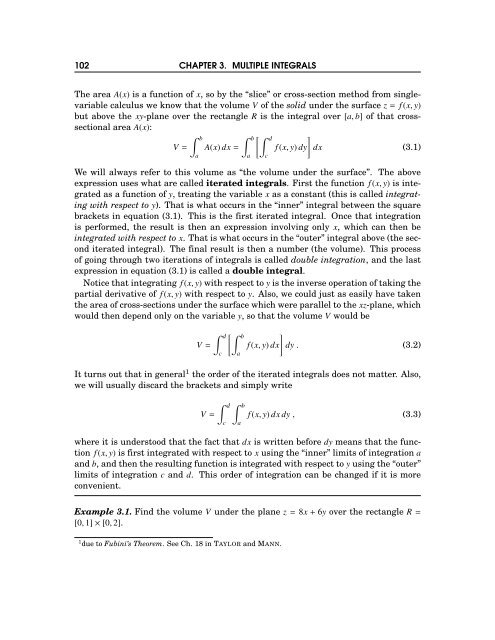Michael Corral: Vector Calculus
Michael Corral: Vector Calculus
Michael Corral: Vector Calculus
You also want an ePaper? Increase the reach of your titles
YUMPU automatically turns print PDFs into web optimized ePapers that Google loves.
102 CHAPTER 3. MULTIPLE INTEGRALS<br />
The area A(x) is a function of x, so by the “slice” or cross-section method from singlevariable<br />
calculus we know that the volume V of the solid under the surface z= f(x,y)<br />
but above the xy-plane over the rectangle R is the integral over [a,b] of that crosssectional<br />
area A(x):<br />
∫ b ∫ b<br />
[∫ d<br />
]<br />
V= A(x)dx= f(x,y)dy dx (3.1)<br />
a<br />
a<br />
We will always refer to this volume as “the volume under the surface”. The above<br />
expression uses what are called iterated integrals. First the function f(x,y) is integrated<br />
as a function of y, treating the variable x as a constant (this is called integrating<br />
with respect to y). That is what occurs in the “inner” integral between the square<br />
brackets in equation (3.1). This is the first iterated integral. Once that integration<br />
is performed, the result is then an expression involving only x, which can then be<br />
integrated with respect to x. That is what occurs in the “outer” integral above (the second<br />
iterated integral). The final result is then a number (the volume). This process<br />
of going through two iterations of integrals is called double integration, and the last<br />
expression in equation (3.1) is called a double integral.<br />
Noticethatintegrating f(x,y)withrespecttoyistheinverseoperationoftakingthe<br />
partial derivative of f(x,y) with respect to y. Also, we could just as easily have taken<br />
theareaofcross-sectionsunderthesurfacewhichwereparalleltothe xz-plane, which<br />
would then depend only on the variable y, so that the volume V would be<br />
V=<br />
∫ d<br />
c<br />
[∫ b<br />
a<br />
c<br />
]<br />
f(x,y)dx dy. (3.2)<br />
It turns out that in general 1 the order of the iterated integrals does not matter. Also,<br />
we will usually discard the brackets and simply write<br />
V=<br />
∫ d ∫ b<br />
c<br />
a<br />
f(x,y)dxdy, (3.3)<br />
where it is understood that the fact that dx is written before dy means that the function<br />
f(x,y) is first integrated with respect to x using the “inner” limits of integration a<br />
and b, and then the resulting function is integrated with respect to y using the “outer”<br />
limits of integration c and d. This order of integration can be changed if it is more<br />
convenient.<br />
Example 3.1. Find the volume V under the plane z=8x+6y over the rectangle R=<br />
[0,1]×[0,2].<br />
1 due to Fubini’s Theorem. See Ch. 18 in TAYLOR and MANN.








